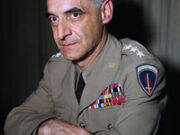General Lucius Clay, a native of Marietta, organized the most remarkable logistical and transportation accomplishment in history, the eleven-month-long Berlin Airlift of 1948-49. He later served as the principal architect of the national interstate highway system and became a successful business executive and a political advisor to U.S. presidents Dwight D. Eisenhower and John F. Kennedy.
The son of Sarah Francis and U.S. senator Alexander Stephens Clay, Lucius DuBignon Clay was born in Marietta on April 23, 1897. He attended the U.S. Military Academy at West Point, New York, from 1915 to 1918 and upon graduation he became a commissioned officer. He married Marjorie McKeown in September 1918; the marriage produced two children. For twenty-two years, as he rose through officer ranks, Clay’s military tours were with the Corps of Engineers or in a teaching capacity at a range of army schools. Then in 1940, as the United States prepared to enter World War II (1941-45), Clay was appointed to the Airport Approval Board. Under his direction almost 500 airports—in North America and worldwide—were constructed or improved. During World War II Clay served as director of materiel under Eisenhower, and he showed a remarkable ability to reestablish supply lines into war-torn Europe as the war neared an end.
After World War II Germany and the city of Berlin were divided into four sections, occupied by British, French, American, and Soviet troops; East Berlin was in the Soviet section. Clay was appointed deputy military governor and then military governor of the American section of occupied Germany. Initially he tried to cooperate with the Soviet Union, but as country after country fell to communism in Eastern Europe, the Soviet Union showed consistent intransigence on issues relating to Germany. For instance, the Soviets flooded the German economy with Soviet-printed money to inhibit economic growth and insisted in January 1948 that Allied supply trains be checked by Soviet troops for approval before being permitted to travel the 110 miles into the Soviet sector to West Berlin. Clay then changed his stance and asserted that the protection of West Berlin and the sectors that would become West Germany was paramount to saving Western Europe from the spread of communism.
On June 23, 1948, after the Allies issued the deutsche mark in a move toward establishing a West German state and rescuing the German economy, the Soviets stopped all road traffic and ended the delivery of coal and electricity into West Berlin in an attempt to starve West Berliners into submitting to Soviet control. Clay quickly secured the U.S. government’s permission to airlift supplies into the city at a rate of more than 140,000 tons a month, and on June 25 American C-47s and other Allied aircraft began flying around the clock, landing at Tempelhof airfield in West Berlin. For eleven months these planes, later joined by much larger C-54s, took off or landed from the field approximately every three minutes. They delivered items ranging from food and clothing to medical supplies. Though the Soviets challenged some of the planes, they reacted as Clay had predicted: they stopped just short of war. Clay’s brinksmanship forced the Soviets to recognize their failure in securing West Berlin, and they agreed to a peaceful resolution brokered by the United Nations. The Berlin blockade ended on May 12, 1949, though Allied flights continued until September.
Clay retired as a four-star general on May 26, 1949. He entered the business world, and in 1950 he was appointed the chief executive officer of Continental Can Company, which he expanded well beyond its original product line with great success. He encouraged Eisenhower to run for president in 1952, and after the election Clay advised the new president on issues regarding Germany. In 1954 Eisenhower appointed Clay to design the Dwight D. Eisenhower National System of Interstate and Defense Highways.
In 1961, when the Berlin Wall was built, President John F. Kennedy called Clay to serve as his representative in West Berlin, and Clay worked diligently to raise citizens’ failing morale. When East German troops refused to let an American official back into West Berlin through the wall checkpoint, he ordered U.S. tanks to the site. Soviet tanks quickly wheeled in to oppose them on the other side, thus supporting Clay’s reason for giving the order: the Soviets, not the East Germans, were actually in charge. The photos of American and Soviet tanks facing each other at the checkpoint became a famous symbol of cold war tensions, but the West Berliners found solace in Clay’s presence. Before he left in 1962, three quarters of a million West Berliners attended a farewell rally.
Upon his return to the United States, Clay continued to serve President Kennedy, sitting on a committee to assess the newly formed Agency for International Development. He retired from Continental Can but served in various capacities with numerous other businesses. He died in Chatham, Massachusetts, on April 16, 1978. At his grave site at West Point is a memorial from the people of Berlin that reads: “Wir danken dem Bewahrer unserer Freiheit” (“We thank the defender of our freedom”).
Clay was inducted into the Georgia Aviation Hall of Fame in 1997.




